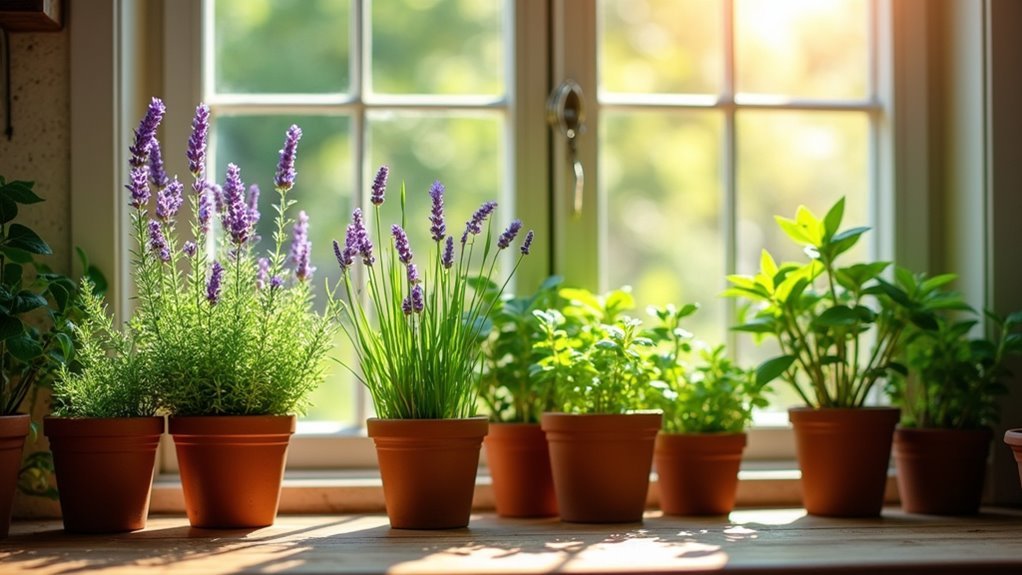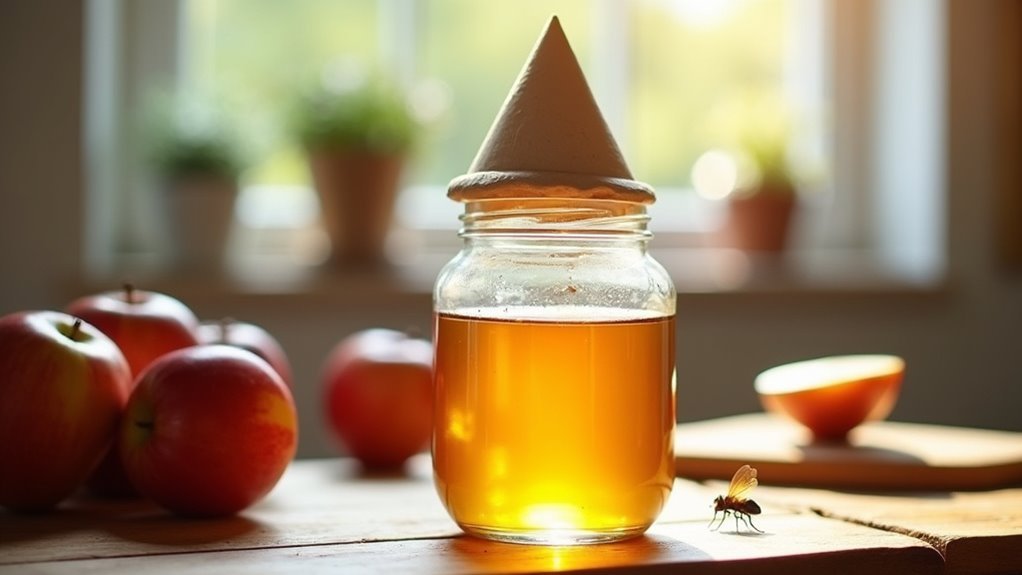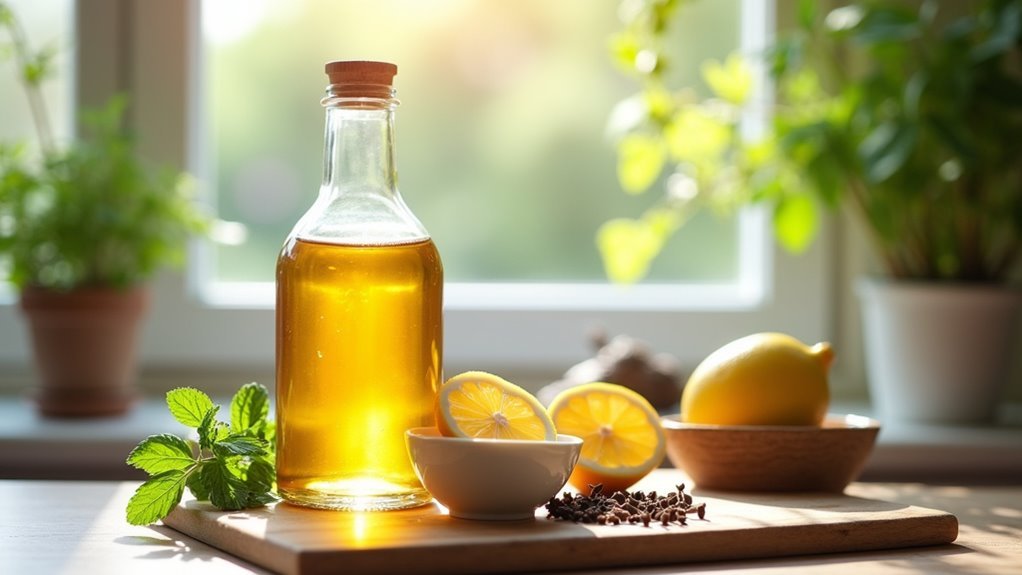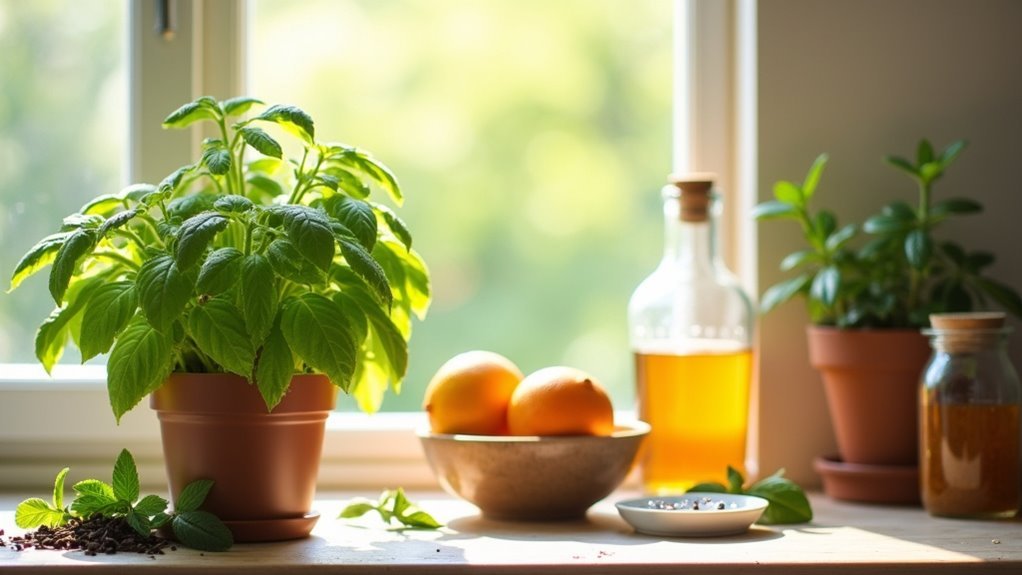You can naturally repel flies using five effective methods that don’t require harsh chemicals. Plant basil, mint, lavender, or marigolds around your home for their strong deterrent aromas. Create essential oil sprays by mixing 10-15 drops of peppermint, eucalyptus, or lemongrass oil with water. Set apple cider vinegar traps by combining equal parts vinegar and water with liquid soap. Place aromatic spices like cloves or cinnamon in fly-prone areas. These simple solutions will transform your home into a fly-free sanctuary.
Essential Plants That Naturally Repel Flies

When flies become a persistent nuisance in your home, certain plants offer a natural and aromatic solution to keep them at bay. Basil’s strong aroma makes it particularly effective when placed in kitchens, where flies commonly gather.
You’ll find that herbs and flowers like mint, lavender, and marigold don’t just beautify your garden—they actively deter flies from entering your living spaces.
These plants work as powerful fly repellents because they emit scents that flies naturally avoid. You can maximize their effectiveness by extracting essential oils from eucalyptus, peppermint, and lemongrass, then spraying these concentrated solutions around your home.
This approach creates a pleasant environment for you while maintaining an unwelcome atmosphere for unwanted flying pests throughout your living areas.
Homemade Essential Oil Spray Solutions
Building on the natural repellent properties of essential oils, you can create powerful homemade spray solutions that effectively deter flies while filling your home with pleasant aromas. Making a homemade fly repellent spray is simple and cost-effective. Mix 10-15 drops of your chosen essential oil with water in a spray bottle for an immediate deterrent.
| Essential Oil | Properties | Best Use Areas |
|---|---|---|
| Lavender | Calming, strong repellent | Bedrooms, living spaces |
| Peppermint | Intense scent, long-lasting | Kitchen, dining areas |
| Eucalyptus | Antimicrobial, potent | Bathrooms, entryways |
For enhanced effectiveness, combine essential oils with witch hazel or vinegar to create dual-purpose cleaning solutions. Regularly spray this repellent spray on doorways, windows, and surfaces. These non-toxic alternatives are safe around children and pets.
Apple Cider Vinegar Traps for Fly Control

While essential oil sprays work well for prevention, apple cider vinegar traps offer a more targeted approach by actively capturing flies that have already entered your home.
You’ll find apple cider vinegar highly effective because flies can’t resist its sweet, fruity scent that mimics fermenting apples. Create your trap by mixing equal parts apple cider vinegar and water in a bowl, then add several drops of natural liquid soap to break surface tension and make sure flies drown.
Cover the bowl with plastic wrap and poke small holes to allow entry while preventing escape. These fly traps work exceptionally well indoors, greatly reducing populations.
Remember to monitor and refresh your solution regularly to maintain its attractiveness and continue capturing flies effectively.
Aromatic Spices and Herbs as Deterrents
Beyond creating traps, you can harness the power of aromatic spices and herbs to create an environment that flies naturally avoid.
Basil serves dual purposes—enhancing your cooking while deterring flies with its fragrant aroma in your kitchen.
Fresh basil leaves strategically placed near cooking areas create a natural fly barrier while keeping aromatic herbs within easy reach for meals.
Place bowls of cloves around fly-prone areas for effective natural repelling, though some may find their scent overpowering.
Cinnamon offers another excellent option, freshening air while keeping pests away.
Mint and lavender provide pleasant fragrances that flies can’t tolerate.
Essential oils derived from lavender, eucalyptus, and lemongrass work exceptionally well when sprayed throughout your home.
These aromatic herbs not only excel at repelling flies but also enhance your indoor air quality naturally.
DIY Surface Cleaning Solutions With Natural Repellent Properties

Since flies avoid certain scents and chemicals, you can create powerful cleaning solutions that simultaneously disinfect surfaces and repel these unwanted pests.
Mix ⅓ hydrogen peroxide with ⅔ water for an effective disinfectant with natural fly-repelling properties. These DIY surface cleaning solutions offer dual benefits while using common household items.
Combine vodka with aloe vera juice and eucalyptus essential oil for another potent cleaner.
Equal parts alcohol-based mouthwash and water create an excellent spray for fly-prone areas.
Witch hazel blended with citronella or lavender essential oils provides gentle yet effective cleaning while naturally deterring flies.
For surfaces where flies frequently gather, mix diluted apple cider vinegar with dish soap.
This solution will repel flies while leaving your surfaces spotless and fresh-smelling.
Frequently Asked Questions
How Do You Keep House Flies Away Naturally?
You’ll keep house flies away by planting herbs like basil and mint, using essential oil sprays, creating vinegar traps, maintaining cleanliness, and placing natural repellents like cinnamon around your home.
What Is the Best Homemade Repellent for Flies?
You’ll find the apple cider vinegar and dish soap mixture works best as a homemade fly repellent. Mix equal parts in a bowl – flies can’t resist the trap and become stuck immediately.
What Smell Keeps House Flies Away?
You’ll find that basil, cloves, lavender, eucalyptus, peppermint, lemongrass, cinnamon, and citrus scents effectively repel house flies. These natural aromas create an environment that flies can’t tolerate, making them excellent deterrents for your home.
Does Vinegar and Dawn Keep Flies Away?
Vinegar and Dawn don’t repel flies – they actually attract them. You’re creating a trap where vinegar’s fruity scent lures flies in, while Dawn’s soap breaks surface tension, drowning them effectively.
In Summary
You’ve now got five powerful natural methods to keep flies away from your home without harsh chemicals. Start with one or two techniques that seem most practical for your situation, then expand your fly-fighting arsenal as needed. Remember, consistency’s key – maintain these natural deterrents regularly for best results. Your family and pets will appreciate the chemical-free environment while you enjoy a fly-free home.





Leave a Reply